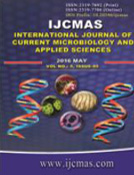


 National Academy of Agricultural Sciences (NAAS)
National Academy of Agricultural Sciences (NAAS)

|
PRINT ISSN : 2319-7692
Online ISSN : 2319-7706 Issues : 12 per year Publisher : Excellent Publishers Email : editorijcmas@gmail.com / submit@ijcmas.com Editor-in-chief: Dr.M.Prakash Index Copernicus ICV 2018: 95.39 NAAS RATING 2020: 5.38 |
The infection wounds remain challenging and present a major global problem leading to many complications. All collected samples, 150 swab from patient’s wounds and hospital units were cultured on different media and tested biochemically. The profile of bacteria in the cultured samples revealed that, Staphylococcus aureus was the most common bacteria and represented in 23 isolates (18%), followed by Pseudomonas aeruginosa with 11 isolates ( 12%). The results showed that, all isolates were completely (100%) resistant to Ceftrixone, Cefepime, Ampicillin–Sulbactam, and Ceftazidime. Psedomonas aeruginosa showed the highest resistance to both Gentamycin, Trimethoprime–Sulfamethoxazole reached to 66.6% and to less extent against Aztreonam (61.1%). Polymerase Chain Reaction (PCR) was used to detect some of Metallo Beta Lactemase MBL genes responsible for antibiotic's resistance in P. aeruginosa isolates as, blaVIM and bla IMP. The results showed that six isolates of P. aeruginosa carried bla VIM, two had bla IMP.
 |
 |
 |
 |
 |